Held annually in Munich, Bavaria, Germany, Oktoberfest is the world's largest volksfest, a 16 to 18-day folk festival running from the third weekend in September to the first weekend in October, which combines old Bavarian traditions with a beer festival.
 |
| A traditional Oktoberfest celebration |
Oktoberfest is an important part of the Bavarian culture, a tradition since 1810, and the folk festival attracts a lot of visitors to Munich, besides also influencing celebrations in many other cities around the world.
The History of the Oktoberfest
The famous Munich Oktoberfest is known worldwide as one of the biggest beer festival, and its origins and evolution represent old Bavarian traditions and culture besides its famous beer. In 2010, the festival celebrated its 200th anniversary, with the yearly celebration, having been interrupted only by wars and cholera epidemics.
Here are some of the important historical events and aspects of the Oktoberfest:
The Royal Wedding on 12 October 1810
The celebration of Oktoberfest started with the royal wedding of King Ludwig I to Princess Therese of Saxony-Hildburghausen on 12 October 1810. The wedding festivities were held on the fields in front of the city gates to celebrate the royal event. The fields were renamed Theresienwiese meaning 'Therese's meadow' to honor the Crown Princess and the citizens of Munich were invited to attend the festivities.
 |
| Therese von Sachsen-Hildburghausen |
Horse races, in the tradition of the 15th-century Scharlachrennen (scarlet race) in Nördlingen, Bavaria, were held in the presence of the royal family to honor the newlyweds and mark the close of the event. The decision to repeat the horse races and celebrations in 1811 launched what is now the annual Oktoberfest tradition.
The Involvement of the Bavarian Agricultural Society
In 1811, besides the horse races a new show was added to the festival to promote Bavarian agriculture as the organization and execution of the event was conducted by the agricultural society. In that period of time, Bavaria was predominately an agricultural society and the state's finances, were dependent in a large part on the proceeds of crops, livestock and other farm products.
 |
| Oktoberfest horse race circa 1823 by Heinrich Adam |
Until 1818, the agricultural society staged Oktoberfest celebrations almost completely on its own and presentations of livestock, equipment and products became a part of the festival along with other contests. Eventually, the cost of organizing the Oktoberfest proved to be a financial burden for the agricultural society of Bavaria.
In 1819, the city of Munich took over the organization of the entire festival, while the agricultural society was responsible for the agricultural exhibitions and various other contests including the marksmanship competition. The festival also expanded to include other amusements like swings, rides and carnival booths.
The agricultural society published, at least until 1845, two publications about Oktoberfest, a pre-festival program and a final report. The Bavarian State Library contains most of these final reports and pre-festival programs printed in the years from 1820 to 1845, providing an important source of information about the Oktoberfest celebrations during this period, and the involvement of the Bavarian agricultural society.
Silver Wedding Anniversary and the Historical Pageant
In 1835, King Ludwig I celebrated his silver wedding anniversary and according to reports published by the agricultural society, the highlight was a great historical pageant on October 4, 1835, featuring traditional Bavarian costumes.
Introduction of Beer Tents and Parades
As the festival grew in size and popularity, it was prolonged and moved forward into September because days are longer and warmer at the end of September, and it allowed guests to enjoy the outdoor fair and also the beer served in stalls, during the warmer September weather.
 |
| Schottenhamel tent which opened in 1867 by Andreas Steinhoff |
The horse race part of the festival ended around the middle of the 19th century but the agricultural show continued. Towards the end of the 19th century, smaller beer stalls were replaced by beer tents as the breweries started getting involved with the festival.
In 1887, the parade of the Oktoberfest staff and breweries took place for the first time which showcased the splendidly decorated horse wagons of the breweries, and featured the bands that played in the festival tents.
From 1950, the traditional costume parade 'Trachten- und Schützenzug' became an annual event and one of the highlights of the Oktoberfest.
Münchner Kindl the Oktoberfest Mascot
Münchner Kindl means 'Munich child' in the Bavarian dialect of German and is the name of the symbol on the coat of arms of the city of Munich. It is the mascot of the Oktoberfest who leads the opening day parade.
 |
| Münchner Kindl - The coat of arms of Munich |
This symbol has been the coat-of-arms of Munich since the 13th century. As the German name for Munich, i.e. München, it means 'of Monks', a symbol for the order of monks, who were the early inhabitants of the city of Munich.
The figure portrayed was originally a monk holding a book, but through the centuries it has been changed unofficially by different artists and presented differently. At the Oktoberfest, a young Munich woman traditionally dons the robes to play the role of the Kindl.
The Celebration of the Oktoberfest
Today, the Oktoberfest in Munich is the largest festival in the world, and combines old Bavarian traditions with an international vibe and guests attending from different parts of the world. The Oktoberfest traditionally takes place during the 16 days up to and including the first Sunday in October.
The longstanding 16 days schedule was modified after the German reunification in 1990, to take into consideration the German Unity Day which is annually celebrated on October 3rd. Therefore if the first Sunday in October falls on the 1st or the 2nd, then the festival would run until 3 October. Thus, the festival now runs for 17 days when the first Sunday is October 2nd and 18 days when it is October 1st.
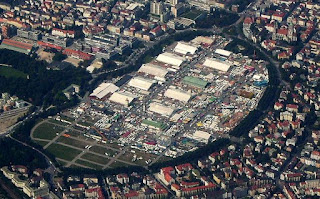 |
| Oktoberfest fairground (Theresienwiese) by Stefan Weigel |
The Oktoberfest is still celebrated in the same area called Thereisienwiese where the first royal wedding celebrations were held. The German word 'wiese' means 'meadow', so Thereisienwiese translates to 'Therese's meadow'. Today, most locals refer to the location and also to the festival as 'Wiesn'.
Parade of Oktoberfest Landlords and Breweries
The tent owners and breweries parade is held on the first Saturday of the festival, one hour before the official tapping of the keg and serves as the official prelude to the Oktoberfest celebration. It showcases the splendidly decorated horse wagons and the big brass bands that play in the festival tents.
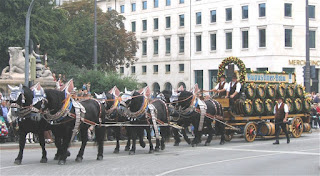 |
| Oktoberfest Augustinerbräu horse wagon parade |
According to tradition, the parade is headed by the Münchner Kindl, followed by the horse cart with the mayor of Munich, and after them, tent proprietors and breweries follow in their wagons.
Official Tapping of the Keg
The Oktoberfest officially starts when the mayor of Munich kicks off the celebration at noon by officially tapping the first beer barrel and declaring to the crowd 'O'zapft is!' meaning, 'It is tapped!'. From that moment on, the festival has officially begun. A gun salute is fired in the air and is a sign for the landlords, who are the tent owners, that they can now begin to sell their beer.
 |
| Official tapping of the keg |
The official tapping of the keg is a tradition that has been done by the mayor of Munich since 1950, and is held at the Schottenhamel tent. It is said that the Schottenhamel tent which has now become the largest festival tent with circa 10,000 seats, was a small beer booth with 50 seats in 1867. Over the years, after having been expanded, it became a meeting point for Munich's wealthiest citizens, officers, nobility and artists.
Traditional Costume and Marksman Parade
Trachten- und Schützenzug which is the traditional costume and marksman parade is held on the first Sunday of the festival. This is one of the cultural highlights of the festival and the parade includes marching groups dressed in traditional Bavarian costumes and also other historical costumes from different parts of Germany and Europe, riflemen, marching bands and floats.
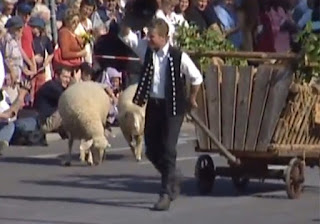 |
| Oktoberfest parade |
In keeping with the past traditions of the Bavarian agriculture society, the parade also includes thoroughbred horses, cows and goats.
Traditional brass band concert
The traditional brass band concert is held on the second Oktoberfest Sunday, where the bands from all the beer tents come together for a concert at the feet of the Bavaria statue. The concert is usually conducted by the mayor of Munich and other local celebrities, during which a variety of the most popular tunes are played, before hundreds of balloons are released into the Bavarian sky.
Tents and Different Entertainment
The beer served at the Oktoberfest can only come from six traditional Munich based breweries. The breweries are: Augustiner, Paulaner, Spaten-Franziskaner, Löwenbräu, Hacker-Pschorr and Hofbräu. The tents are often run by the same Munich based families for generations, many of the tent proprietors also run restaurants and beer gardens throughout Munich.
 |
| Oktoberfest rides and roller coasters by Michael Chlistalla |
Despite all the flowing beer, Oktoberfest is a family-friendly festival with carnival rides, carousels, roller coasters and musical showcases. Every Tuesday is Family Day, and special discounts are given on rides between noon and 6 p.m. The traditional religious Oktoberfest mass is held on the first Thursday.
Oktoberfest music includes traditional Bavarian Blasmusik played from brass instruments, German hits and occasionally international pop songs.
Traditional Gun Salute
On the last day of the Oktoberfest, the traditional gun salute 'Böllerschießen' takes place at noon at the Bavaria statue where members of Bavaria's traditional sports shooting clubs assemble and fire their rifles and black-powder cannon pistols to herald the close of Oktoberfest.
The Culture of the Oktoberfest
The culture of Oktoberfest reflects the Bavarian traditions and their keen sense of community, sociability and passion for enjoying life’s simple pleasures of food and drinks with family and friends.
 |
| Dirndl from the 70s by Florian Schott |
Bavarians commonly emphasize pride in their traditions and folklore costumes play a huge role in Bavarian life, more so than in any other state of Germany. Traditional costumes collectively known as Tracht are worn on special occasions such as the Oktoberfest and include Lederhosen for males and Dirndl for females.
The food and beer served at the Oktoberfest represents the Bavarian pride in their local cuisine. Bavarians consume many items of food and drink which are unusual elsewhere in Germany.
 |
| Traditional Munich breakfast with Weißwurst |
Weißwurst which translates to 'white sausage' is a traditional Bavarian sausage served at the Oktoberfest. There is a Bavarian saying that the sausages should not be allowed to hear the noon chime of the church bells and hence they are traditionally eaten before noon. The strong difference in culinary culture and traditions between Bavaria and Central Germany is informally expressed by the term 'Weißwurstäquator' which means 'white sausage equator'.
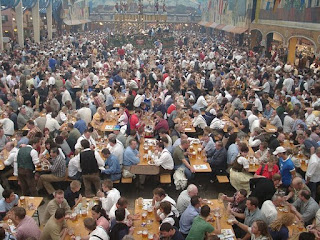 |
| Oktoberfest tent |
Oktoberfest also highlights the importance of the beer garden culture to Germans and their keen sense of community. Beer gardens which first originated in Bavaria, offer a great alternative for many Germans to take a break from their daily routines and rigidity of structures to enjoy beer and food in a fun, relaxed communal setting and engage in lively conversations on different topics of interest.
Recommended Reading
History and Culture of Germany's Beer Gardens
Article Category: Drinks & Culture














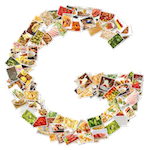

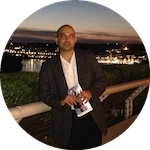
No comments